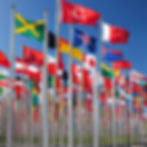The 10 Most Translated Languages Worldwide in 2023
- Silver Bay Translations
- Apr 29, 2024
- 3 min read
In an era of global communication and connectivity, language serves as a powerful tool for fostering understanding, collaboration, and cultural exchange. As ideas and stories traverse borders, certain languages emerge as pivotal conduits for translation, enabling the dissemination of knowledge and expression of diverse perspectives on a global scale. In this blog, we'll explore the 10 most translated languages worldwide in 2023, highlighting their significance in shaping our interconnected world.
English:
English continues to reign supreme and was the most translated language worldwide in 2023. With over 1.5 billion speakers and its status as a global lingua franca, English serves as the primary language for international communication, business, science, and entertainment. Translations of English literature, academic papers, and digital content are in high demand across diverse cultures and regions.
Spanish:
Spanish claims the second spot as one of the most translated languages globally. With approximately 460 million speakers and its widespread usage across Latin America, Spain, and the United States, Spanish-language literature, films, and cultural works are sought after for translation, fostering cross-cultural understanding and appreciation.
French:
French maintains its significance as a highly translated language worldwide. With around 300 million speakers and its status as a language of diplomacy, culture, and intellectual discourse, French-language literature, philosophy, and academic texts continue to captivate global audiences, driving demand for translations in various fields.
Chinese (Mandarin and Cantonese):
Chinese emerges as a major player in the global translation landscape. With over a billion speakers worldwide and China's growing influence in business, technology, and culture, translations of Chinese literature, scientific research, and digital content are increasingly sought after, reflecting the importance of Mandarin and Cantonese dialects.
Arabic:
Arabic was fifth on the list of the most translated languages worldwide in 2023. With approximately 310 million native speakers and its significance as the language of the Quran and Islamic scholarship, Arabic-language texts in literature, religion, and philosophy are in demand for translation, contributing to cross-cultural dialogue and understanding.
German:
German holds a prominent position as one of the most translated languages globally. With over 100 million speakers and its reputation for precision engineering, philosophy, and literature, translations of German works play a significant role in disseminating knowledge and culture across linguistic boundaries.
Russian:
Russian emerges as a key language for translation worldwide. With around 260 million speakers and its historical and cultural significance, Russian-language literature, scientific research, and political discourse are translated into numerous languages, facilitating dialogue and exchange on a global scale.
Portuguese:
Portuguese holds a strong presence as one of the most translated languages globally. With approximately 260 million speakers and its cultural richness across Brazil, Portugal, and other Lusophone countries, translations of Portuguese literature, music, and film contribute to cultural diversity and exchange worldwide.
Japanese:
Japanese plays a significant role in the global translation landscape. With over 130 million speakers and Japan's influence in technology, anime, and popular culture, translations of Japanese works appeal to audiences worldwide, showcasing the richness of Japanese language and culture.
Italian:
Italian rounds out the top 10 most translated languages worldwide in 2023. With over 65 million speakers and its legacy of art, cuisine, and literature, translations of Italian works continue to captivate global audiences, highlighting Italy's contributions to world culture and heritage.
The 10 most translated languages worldwide in 2023 reflect the linguistic diversity and cultural richness of our interconnected world. From English and Spanish to French, Chinese, Arabic, German, Russian, Portuguese, Japanese, and Italian, these languages serve as bridges that connect people, ideas, and stories across continents and civilizations. By embracing linguistic diversity and promoting translation efforts, we can foster mutual understanding, appreciation, and collaboration, enriching our shared human experience in the process.






















